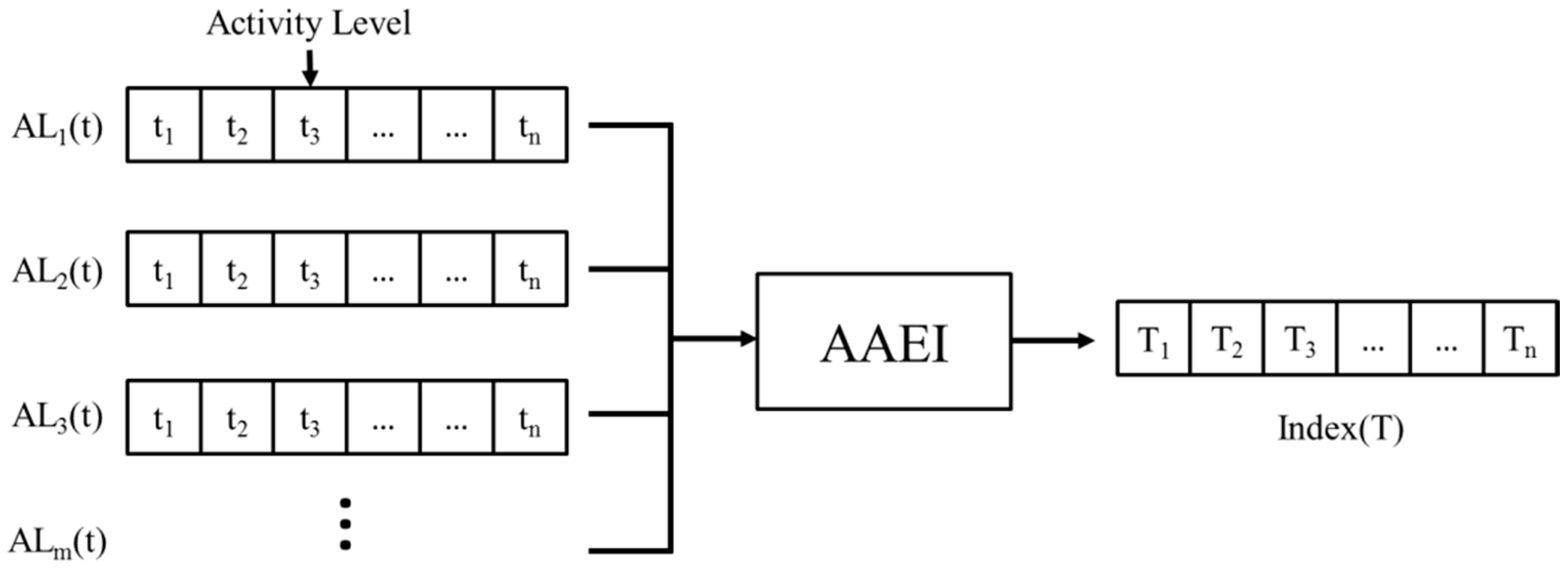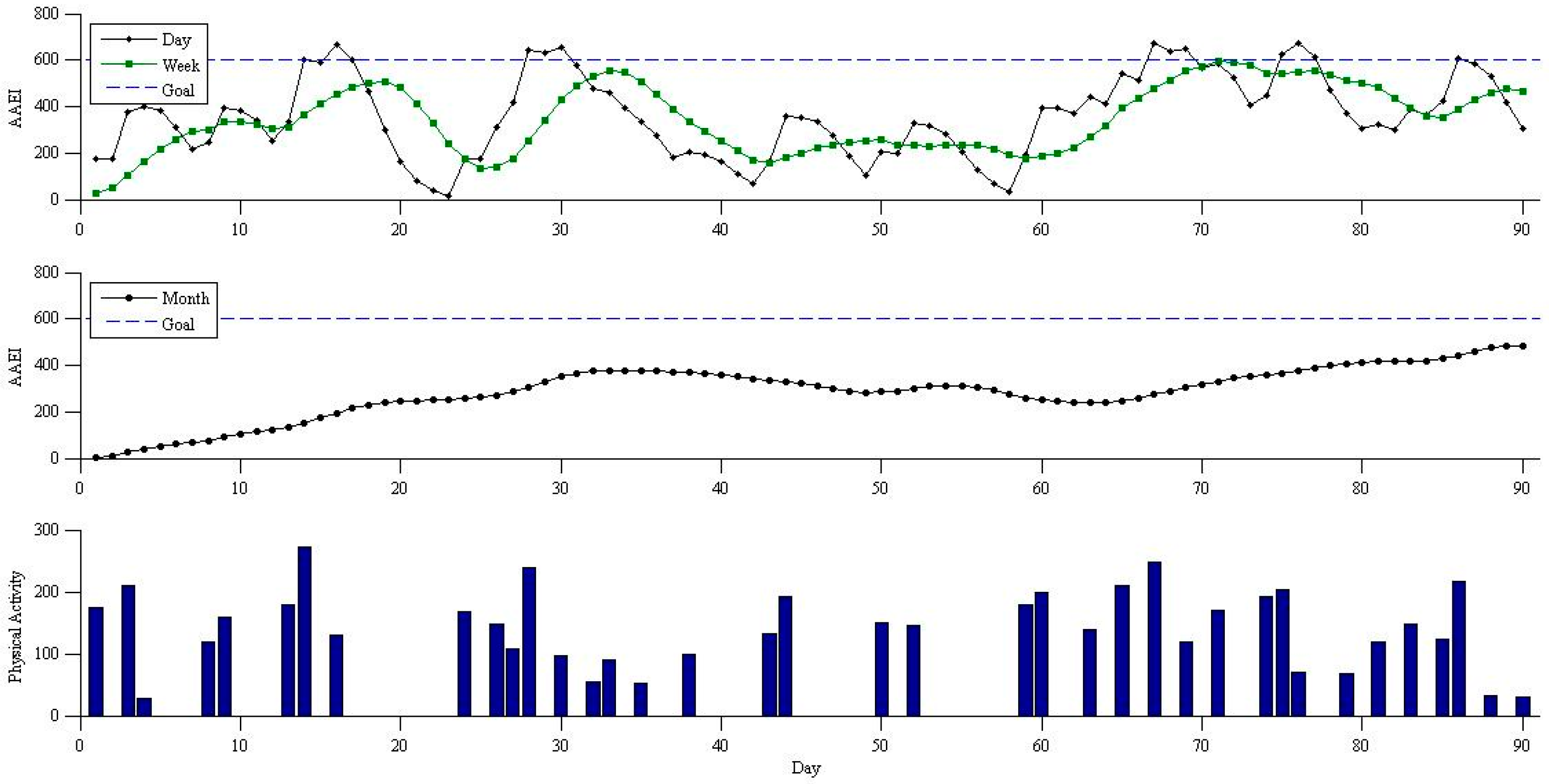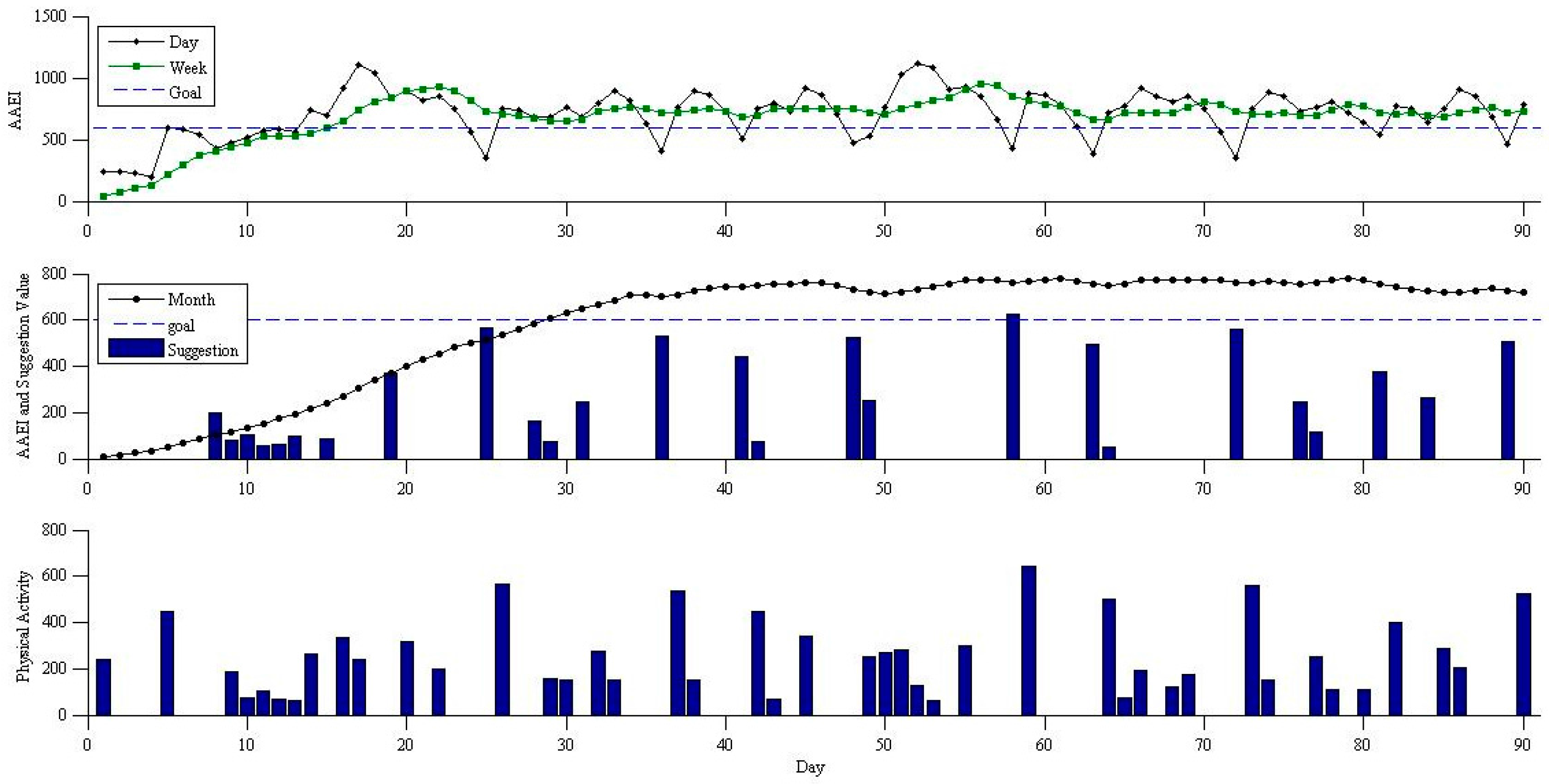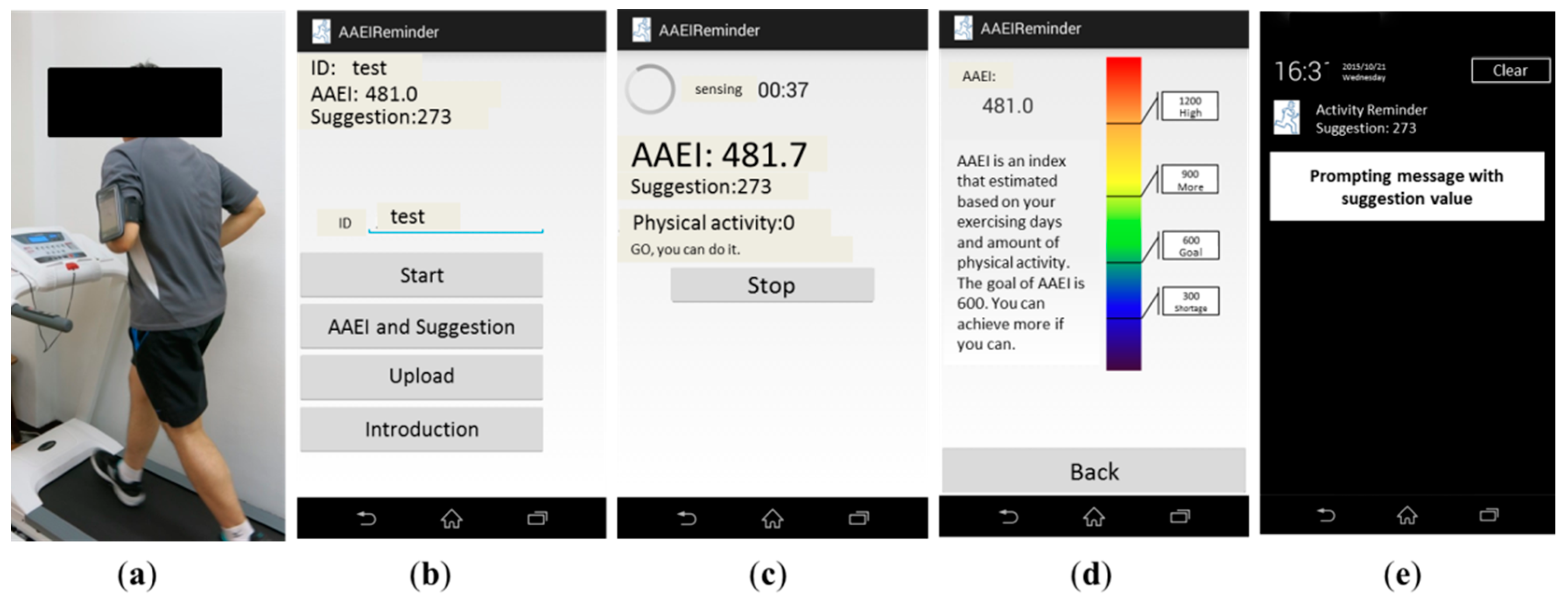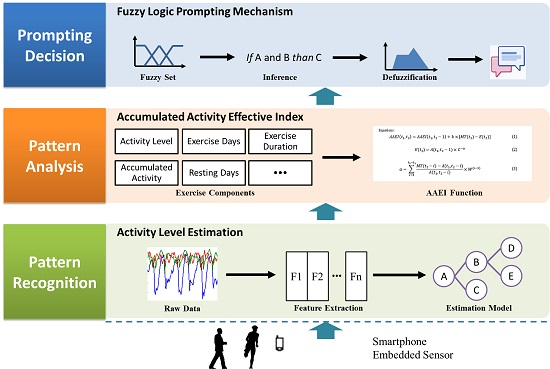The architecture of the proposed fuzzy logic prompting mechanism is illustrated in
Figure 1. The prompting system uses fuzzy logic to decide whether prompts should be delivered based on an individual’s exercise performance. In our system, fuzzy logic is an approach to compute the degrees of sufficient physical activity. We also use experts’ knowledge to set rules for reasoning because there is no certain value to indicate the degrees of exercise performance [
7,
8]. We used a smartphone-embedded accelerometer, which was worn on a user’s left upper arm, to sense physical activity. The raw data sensed by the accelerometer were processed through an activity level estimation stage to estimate the level of activity performed by users. The activity level estimation comprises multiple components, which are the signal preprocessing, segmentation, feature extraction, and estimation model. Because walking and running are everyday physical activities, we estimated these two physical activities. Physical activity, such as people’s amount of physical activity and days spent exercising, are the basic elements for making decisions. However, a large amount of personal physical activity information may also complicate for automated systems and not be suitable for a mobile system. Consequently, we used an accumulated activity effective index to rate individuals’ physical activity based on a numeric index to enhance the decision-making of our prompt. The AAEI is a numeric indicator that estimates individuals’ exercise based on their activity levels and days of exercising [
10]. The activity level was then used at the accumulated activity effective index stage to analyze exercise performance. The AAEI was proposed to estimate physical activity and generate a numerical index based on several components such as amount of physical activity and days spent exercising. Prompting decisions were made based on the AAEI results. The fuzzy logic prompting mechanism makes prompting decision once a day and delivers a prompt message that depends on exercise performance. Users can read the suggestion before exercising and receive a prompt if their physical activity is not sufficient.
2.1. Pattern Recognition and Activity Level Estimation
Physical activity can be measured as energy expenditure by using the metabolic equivalent of task (MET) as a unit to quantify activity level [
11]. Activity level is increased with the intensity of physical activity. Sedentary intensity is defined as approximate 1 MET [
11]. It is estimated that compared with sedentary intensity, a person’s caloric consumption is one to three times higher when being lightly active (1–3 METs), three to six times higher when being moderately active (3–6 METs), six to nine times higher when being vigorously active (6–9 METs) and more than nine times higher when being very vigorously active (>9 METs). Activity level can be determined using questionnaires, biomedical methods (ex. Doubly Labeled Water), and sensors [
11,
12]. Compared these methods, sensors have the advantages of being inexpensive, objective, and suitable for creating individual records for estimating activity level. The technique issues such as battery life and friendly user interface design are however challenges for sensor measurement.
The mechanism of pattern recognition and activity level estimation in the prompting system uses a multi-stage process comprising four processes, which are signal preprocessing, segmentation, feature extraction, and classification, as shown in
Figure 2. The accelerometer embedded in the smartphone records the raw exercise data that contains gravity and motion acceleration. The sampling rate is 40 Hz.
Before estimating the activity level, the gravity should be separated. A low pass filter is used in the preprocessing stage to separate gravity and motion data, which are linearly combined in the raw data as shown in
Figure 3 [
13]. The low pass filter is a two-order elliptical infinite impulse response filter with cut-off frequency at 0.5 Hz. The filter can approximately to separate gravity and motion acceleration. The motion acceleration is then taken as the difference between the raw data and gravity. Then the body motion signal uses a window technique to divide the continuous motion signal into segments with a window size of two seconds. The window size impacts the activity level estimation. A smaller window size can detect physical activity faster and with reduced resources. A larger window size is suitable for detecting complex physical activity [
14]. To develop a pattern recognition using smartphones for real-time application, the processing time and data buffer are constrained. In our system, two seconds provides a good trade-off between of estimation speed and accuracy [
14], so we set a two seconds data buffer for segmentation.
The features are extracted from the motion acceleration segmentation to be a feature vector. Previous studies have generated many features for pattern recognition [
11,
13,
15,
16,
17,
18,
19]. Time-domain and frequency-domain features are often generated to characterize information within time-varying signals [
18]. Time-domain features are generated directly from segmentation of sensor data. Frequency-domain features are derived from frequency domain data which are transformed from sensor data. The Fast Fourier Transform (FFT) is widely used to transform the sensor data to frequency domain data [
18]. To decrease the resources needed and processing complexity, we selected several time-domain and frequency-domain features. The features are generated and selected based on several well-known studies [
10,
11,
13,
15,
16,
17,
18,
19]. The feature vector contained the signal magnitude vector, signal magnitude area, maximum value of y- and z- axis, and the first three magnitude values and frequencies of the Fast Fourier Transform. The feature vector is used to classify the different activity level by Decision Tree algorithms [
18]. The estimated activity level consisted of walking, fast walking, running, and being stationary, since walking, fast walking and running are ordinary physical activities and often performed by people. The activity categories and corresponding activity levels are defined in
Table 1.
The estimation model used C4.5 Decision Tree algorithm to identify various activity level categories. The C4.5 Decision Tree algorithm is one of the most extensively and successfully machine learning techniques used to classify categories in previous recognition problems [
14,
18]. Decision Tree algorithms have the advantages of ease of coding, fast prediction, and ease of model construction. To construct the activity level estimation model, we recruited seventeenth participants to perform walking, walking fast, and running on a treadmill. The participants walked and ran at different speeds at their own pace. The age of participants was 22.5 ± 2.3 years old. Participants wore the smartphone on their left upper arm to collect the motion data, which are used to construct the C4.5 Decision Tree algorithm. Participants were asked to perform walking, and walking fast at speeds from 1 to 7 km/h. Running was performed at speeds from 6 to 9 km/h. Each speed was maintained for at least 2 min in increments of 1 km/h. In the training phase, a Decision Tree model with a labeled feature vector is used to build the activity level estimation model. The activity level estimation model is validated by 10-fold cross validation. The precisions of the estimation models of light, moderate, vigorous, and very vigorous intensity are 94%, 81%, 88%, and 74%, respectively. The generated estimation model is then implemented in a smartphone to estimate activity levels. The activity level estimation algorithm is presented in
Figure 4.
The activity level estimation algorithm is coded in an Android smartphone. The raw data is time sequence data incoming in real-time. To reduce resource needs and processing time, the algorithm estimates the activity level for each segment. The activity level output is time sequence data based on the duration of the recording time. There is consecutive time sequence data for each estimation. The amount of physical activity is the activity level multiplied by the time duration. The return of time sequence activity level is the basic context for prompting a decision.
2.2. Activity Effective Analysis and Accumulated Activity Effective Index
The AAEI is a stage to analyze exercise performance for mobile and real-time applications. The activity level is time data sequence which is estimated by the pattern recognition and activity level estimation stages. The activity level is given by the consecutive time sequence data when the system monitors the exercise performed by a user. The user may have exercised several times in one day. Each time may have different exercise durations. The days spent exercising and resting days may change according to the user’s personal situation. The amount of physical activity and accumulated amount of physical activity may vary while the user exercises in a period of time. Therefore, the consecutive time sequence activity level data are numerous. The system needs a lot of resources to record and analyze this data if we directly make prompting decisions based on these abundant time sequence data.
Figure 5 shows how AAEI can combine several time sequence data into one time sequence dataset. AAEI can summarize activity level with an index. AAEI is used to analyze time series activity level data and reduce the complexity of the activity level.
The AAEI can indicate the extent to which users perform physical activity. The AAEI is designed as a numeral indicator that reveals the exercise performance of users after the pattern recognition stage. As shown in
Figure 5, the consecutive time series activity level,
, can be summarized by AAEI to an set of indexes. The time unit of
is days, that is we measure exercise performance of users per day. The features of the AAEI are as follows: (a) the AAEI is related to the amount of physical activity accumulated in seven days. The AAEI increases if physical activity increases, remains constant if physical activity is constant, and decreases if physical activity decreases; (b) the AAEI is related to resting days. The AAEI decreases if the number of resting days increases; (c) the AAEI decreases more during periods of continuous rest than during intermittent rest; (d) the AAEI decreases less at rest if users had exercised before resting; and (e) the AAEI level is near zero if users rest for more than 7 days. The AAEI is used for both providing feedback to users and making prompt decisions. The AAEI and related parameters (
Table 2) are described as follows [
10]: Equation (1) shows how the AAEI index (
) is estimated from a previous AAEI index (
), the current amount of physical activity (
), and the threshold (
). The threshold is used to decrease the AAEI index when there is a lack of physical activity. The threshold is determined by the accumulated amount of physical activity as shown in Equation (2). Equation (3) shows the estimation coefficient (
) of the accumulated amount of physical activity:
2.3. Fuzzy Logic Prompting Mechanism
The reminder makes prompt decisions based on AAEI values. Two decisions are as follows: (1) does the situation require a prompt; and (2) how much exercise should be prompted. The reminder’s decision-making principle is to help people achieve and maintain the goal of sufficient physical activity. The AAEI estimated for sufficient physical activity is 400–600 based on different exercise days and activity levels [
10]. We choose 600 for the fitness goal because 600 is a high standard of sufficient physical activity. As shown in
Figure 6, the exercise performance can be assessed and drawn as an AAEI dotted line. The average AAEI line represents the last 7 day average AAEI. The average AAEI line is estimated from individual users. To achieve this goal, the AAEI should be elevated above the average AAEI to increase the average AAEI. Prompts should be delivered if the AAEI is below the average AAEI during the achievement phase. After achieving the goal, the prompting system delivers prompts to help people maintain their fitness goals. The prompts are designed to be delivered if the average AAEI falls below the goal.
The framework of the fuzzy logic prompting system is shown in
Figure 7. When the system follows the prompting principles in the achievement and maintenance phases, the inference rule is applied. The inputs of the fuzzy logic prompting system are the goal, AAEI, and AAEI prediction. The AAEI is the estimated AAEI values recorded every day. The AAEI prediction is used to predict the physical activity status of a person. If the prompting system made a prompting decision based on the AAEI history, the prompts would be delivered after the situation occurred. For example, if the situation “user has failed to maintain the fitness goal” happens, then the prompts would then be delivered to the user. To deliver prompts before a potential failure situation happens, AAEI prediction is used to estimate possible failures. The AAEI prediction sets users’ physical activity at zero to estimate the tomorrow’s AAEI and takes into account the prompting decision. If the decision to prompt is positive, the prompting value will be estimated. The procedures of the fuzzy logic prompting mechanism are described as below.
2.3.1. Convert Inputs into Fuzzy Sets
Fuzzy membership function is usually determined by the perception of the linguistic terms, experimental data and simulation. Triangular and trapezoidal fuzzy membership functions have been widely used in the construction of fuzzy membership functions [
7,
8]. The trapezoidal fuzzy membership function is easy to construct and rational for two groups which are high and low as shown in the
Figure 8. The prompting mechanism sets four estimated factors based on the inputs. The input factors and a prompting level (PL) are converted to matching to fuzzy membership functions. The fuzzy membership functions are shown as
Figure 8.
Based on Equations (1)–(3), the four estimated factors are described as follows:
where
, is the fitness goal. The principle of prompting rules is that the AAEI should be above the last seven days’ average AAEI in the achievment phase and the last seven days’ average AAEI should above the goal in the maintenance phase. The four estimated factors are estimated based on the principles. Factor
(predictive factor) and
(phase locating factor) are estimated based on the principle of “the AAEI should be above the seven day average AAEI” while factor
(phase factor) and
(maintenance factor) are estimated based on the principle of “the seven day average AAEI should be above the goal”. AAEI, AAEI prediction and goal are the elements of the estimation factors.
The factor
describes the difference between predictive seven days average AAEI and predictive AAEI. The “predictive AAEI” represents that the mechanism estimates the AAEI value of the user without any physical activity tomorrow. Based on Equation (1), the predictive AAEI becomes:
Predictive seven days average AAEI is the average of six known AAEI from today to five days ago and one predictive AAEI. Based on the Equations (1) and (8), the predictive seven days average AAEI,
, becomes:
Based on the Equations (8) and (9), the difference between predictive seven days average AAEI and predictive AAEI is shown as Equation (4). Following the principle of “the AAEI should above the seven day average AAEI,” the description “if user does not exercise tomorrow and the AAEI is below the average AAEI, the prompt should be delivered” can be constructed. Factor
estimates the difference between AAEI and the seven day average AAEI tomorrow, which is based on the principle. Factor
is converted to a fuzzy set as shown in
Figure 8a.
Factor estimates the difference between the goal and the predictive AAEI. It is a factor to estimate whether the user is achieving the goal or not. Considering both factors and , the principle “the AAEI should be above the seven day average AAEI in the achievement phase,” can be measured. The degrees of factors and are the perception of the linguistic terms for inference.
Factor
estimates the difference between the goal and the seven day average AAEI. Factor
measures the level of the user in achieving the goal. Factor
estimates the difference between the goal and the predictive three days average AAEI. Considering both factors
and
, the description “if the user’s average AAEI will below the goal, the prompt should be delivered” can be constructed. The description follows the principle of “the average AAEI should be above the goal in the maintenance phase.” The factor
is converted to match the fuzzy membership function as shown in
Figure 8a. The factor
is converted to the match the fuzzy membership function as shown in
Figure 8b.
2.3.2. Fuzzy Inference
Relations of
,
,
, and
are constructed in a form of
if-then rules. Rules are made based on the description in
Figure 6. Two principles are made for inference: (1) AAEI should be above the seven day average in the achievement phase; (2) the seven days average AAEI should not be below the goal in the maintenance phase. The fuzzy inference then generates a mapping between input factors and output. Equation (10) describes the construction of the factors and prompting level in the form of
if-then rules:
where
and
are estimated factors;
,
, and
denote the membership functions of
,
, and
PL, respectively;
,
is the
rule in the inference rule.
For example, the rule 1 “If
is high and
is high then PL is high” is made based on the principle “AAEI should above the seven day average in the goal achievement phase”. The rule 5 “If
is high and
is high then PL is high” is made based on the principle “The seven day average AAEI should not below the goal during the maintenance phase”. The rules in the prompting mechanism are shown in
Table 3.
The rules can be inferenced after the rules are made. The rule is inferenced by a fuzzy intersection (minimum) operation. The output of
rule
is described as follows:
To determine the inference result, the aggregations of rules use the fuzzy union (maximum) operation. The outputs of rules are aggregated with “and” in fuzzy logic. As described below,
is the result of the fuzzy inference:
where
n is the total number of rules.
2.3.3. Defuzzification and Prompting Value
The output of the fuzzy inference is a fuzzy set. Defuzzification is applied to convert the fuzzy result into a matching value. The membership function of the prompting level is shown in
Figure 8c. The prompting system uses the Center of Area method for defuzzification. The Center of Area method calculates the center of gravity of the fuzzy inference. The prompting level can be calculated as follows:
where
is the number of quantization levels of the output,
is the amount of control output at the quantization level
, and
denotes to fuzzy membership function value in
.
The prompting level is obtained after defuzzification. The prompting level is the final result to measure the prompting need. We set a threshold at prompting level 5 based on the simulation and experimental data to determine whether a prompt should be sent. If the prompting message is decided to be delivered, the prompting value is then estimated as described in Equations (14)–(16). The prompting value (PV) is determined based on two elements: the value to achieve the seven day average AAEI and the value for progressing.
The value to achieve the last seven day average AAEI is determined based on Equations (1–3). The value to achieve the seven day average AAEI is made based the prompting principles. The value to achieve the seven day average AAEI can ensure that the user stays physically active. The value for progressing is determined for increasing the physical activity. We expect that users can make progress based on their previous physical activity. We set the progress value to increase the physical activity based on the seven day average AAEI multiplied by the percentage of prompting level. The minimum progress goal is 50 because this value corresponds to moderately intense walking for 10 min.




